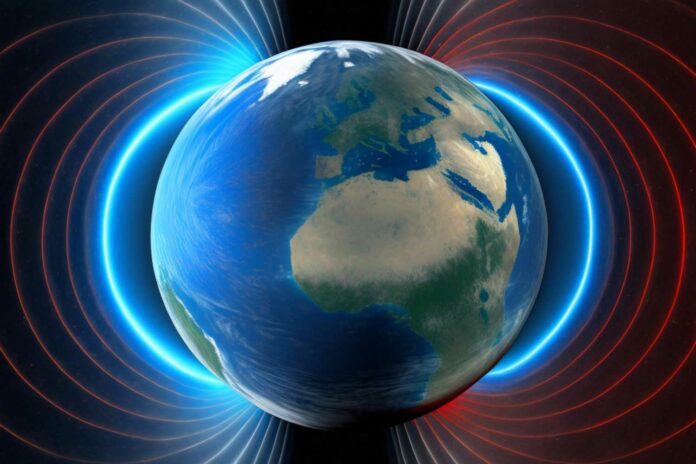Life on Earth would not be possible without the magnetic field that protects us from the Sun’s charged particles and dangerous cosmic radiation (known as the “solar wind”). However, a trustworthy date for creating a current magnetic field has yet to be determined.
A new study, led by the University of Oxford and MIT, has recovered a 3.7-billion-year-old record of Earth’s magnetic field and found that it appears remarkably similar to the field surrounding Earth today.
Scientists examined an ancient sequence of iron-containing rocks from Isua, Greenland. When crystallization fixes iron particles in place, they function as tiny magnets that record the direction and strength of magnetic fields. Researchers discovered that rocks from 3.7 billion years ago had a magnetic field strength of at least 15 microteslas, equivalent to today’s magnetic field (30 microteslas).
Compared to earlier research that used single crystals, these findings offer the oldest estimate of the Earth’s magnetic field strength generated from complete rock samples, which yields a more accurate and trustworthy evaluation.
Lead researcher Professor Claire Nichols (Department of Earth Sciences, University of Oxford) said: ‘Extracting reliable records from rocks this old is extremely challenging, and it was fascinating to see primary magnetic signals begin to emerge when we analyzed these samples in the lab. This is a crucial step forward as we try to determine the role of the ancient magnetic field when life on Earth was first emerging.’
While the magnetic field strength appears to have remained relatively constant, the solar wind is known to have been significantly more vital in the past. This suggests that the protection of Earth’s surface from the solar wind has increased over time, which may have allowed life to move onto the continents and leave the protection of the oceans.
The Earth’s magnetic field is generated by a dynamo formed by the spinning liquid iron in its outer core. Researchers have long questioned how the magnetic field existed when the Earth was young and its core had not yet solidified.
According to a recent study, the process was similar to today’s when the core solidifies. Our understanding of the evolution of Earth’s magnetic field strength allows us to determine the formation date of the solid inner core. This aids in our comprehension of the Earth’s internal heat flow, which is crucial for understanding the movement of the Earth’s plate tectonics.
Any action that heats the rock can change stored signals, making recreating Earth’s magnetic field thus far back in time extremely difficult. Previous knowledge of magnetic fields is frequently lost due to the lengthy and intricate geological histories of rocks in the Earth’s crust.
The Isua Supracrustal Belt, on the other hand, has a distinct geology because its thick continental crust shields it from significant tectonic activity and deformation. As a result, scientists were able to accumulate substantial evidence that the magnetic field existed 3.7 billion years ago.
Study co-author Professor Benjamin Weiss (Massachusetts Institute of Technology) said: ‘Northern Isua has the oldest known well-preserved rocks on Earth. Not only have they not been significantly heated since 3.7 billion years ago, but they have also been scraped clean by the Greenland ice sheet.’
The results may also shed light on how Earth’s magnetic field affected the creation of our atmosphere, particularly about gas escape. One mystery is why xenon, a gas, vanished from our atmosphere more than 2.5 billion years ago. It’s odd that the xenon drifted away because it’s a hefty material. Researchers are investigating the possibility that the magnetic field drew charged xenon particles out of the atmosphere.
Scientists are now looking forward to expanding our knowledge of Earth’s magnetic field before the rise of oxygen in Earth’s atmosphere around 2.5 billion years ago. They will examine other ancient rock sequences in Canada, Australia, and South Africa.
Comprehending the strength and unpredictability of Earth’s magnetic field in the past can help determine the significance of planetary magnetic fields in supporting life on a planet’s surface and their function in atmospheric development.
Journal Reference:
- Claire I. O. Nichols, Benjamin P. Weiss et al. Possible Eoarchean Records of the Geomagnetic Field Preserved in the Isua Supracrustal Belt, Southern West Greenland. Journal of Geophysical Research: Solid Earth. DOI: 10.1029/2023JB027706
